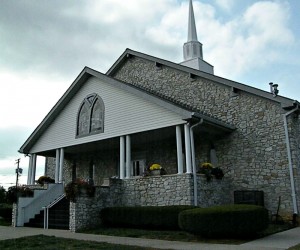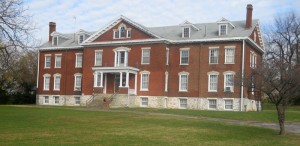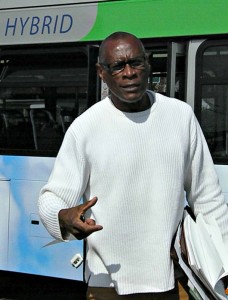On the “When separate is not equal” bus
By Laura Webb
On the afternoon of Saturday, October 13, NoC’s Film Department and I went willingly to a type of space we usually avoid: a church parking lot. Granted, we were not there in search of eternal salvation (much to my relatives’ disappointment, I’m sure), but instead as attendants of the Central Kentucky Council for Peace and Justice’s bus tour of Historic Lexington, part of its ongoing “Voices” event series. The theme of this year’s series, “When Separate is Not Equal: Yesterday and Today,” focused on segregation and the struggle for civil rights.
From African American enclaves such as Kincaidtown (now known as the East End) to more recent inconsistencies in downtown restoration and development, Lexington has a long history of creating segregated spaces. Official area histories tend to recognize, and city revitalization efforts tend to prioritize, the upkeep and maintenance of spaces coded white and upper-class, often directly at the expense of black neighborhoods, landmarks and histories.
To cite one example, the popular Cheapside park — home to the recently developed Fifth Third Bank Pavilion and the substantial Lexington Farmer’s Market, as well as other well-publicized events — features prominent statues lauding two Kentucky Confederates, John Hunt Morgan and John C. Breckinridge. In revitalizing the area, the Breckinridge statue was moved to an even more prominent location abutting Main Street. Meanwhile, the square’s historical role as a slave market was only overtly acknowledged with a historical marker in 2003, and even then this marker is effectively hidden behind the old courthouse and beneath a tree. (It goes without saying that the plaque was left untouched during the recent renovation that moved the Breckenridge statue.)
Given the general lack of citywide interest in acknowledging landmarks important to Lexington’s African American community, a tour focused specifically on black landmarks about town naturally drew my attention. I was far from disappointed. Our guide, Yvonne Giles (founder and director of the Isaac Scott Hathaway Museum Gallery), amazed me with her depth and breadth of knowledge.
Wiping the landscape
As our new hybrid bus departed from First African Baptist Church, Giles began to outline the processes that would recurrently arise throughout the tour. Historically, black spaces such as hospitals and cemeteries were physically separated from white ones. As the city developed over time, important black spaces have been lost even as corresponding white spaces have been preserved.
At times it felt odd to be circling the blocks around my house and realize that not too far away from it were places I had never heard of, a sentiment echoed among many of the bus’s other passengers. Case in point: the former “Colored Orphan Industrial Home,” a stone’s throw away from the Eastern State Hospital campus (and future BCTC campus), on Georgetown Street. Historically an orphanage and retirement home for Lexington’s African-American community, this stately brick building is now the Robert H. Williams Cultural Center, which, appropriately, houses Giles’ Isaac Scott Hathaway Museum.
As I would find out on our tour, the Industrial Home was comparatively lucky: its building is still standing. Lexington’s Colored Fair, which was not only financed and operated by the city’s black community but was also arguably the largest and most successful in the country (its first run attracted about 10,000 attendees), now exists as a historical marker on Georgetown Pike. Baseball fields have become industrial parks; farms and fairgrounds are now suburban housing tracts. As our bus rambled along Lexington’s streets, I had difficulty piecing together what I saw out the window with what I heard about it inside.
Of course, this pattern of destruction, development and change takes place in every city: not every place and structure can be preserved. The tour highlighted, however, the noticeable discrepancy between whose spaces were and were not preserved.
The consequences of this discrepancy reach further than simple nostalgia. As Douglass Appler, the Helen Edwards Abell Endowed Chair in Historic Preservation, stated at the University of Kentucky’s sixth annual historic preservation symposium, “If the history of a particular group is wiped from the landscape, its past can’t be explored or recognized to the same degree as that of another group whose history is left in place and remains standing.”
Scavenging history
Lexington and Fayette County have many historic spaces; among their most prominent and well-preserved are, of course, the slave-owning estates of Ashland, Waveland and the Mary Todd Lincoln House. Meanwhile, the material history of slaves and their descendents lie largely beneath our feet, cropping up haphazardly and if you know where to look. Trouble is, most Lexingtonians don’t know where or how to look.
Throughout the bus trip, I was strangely reminded of walking the streets of Cuzco, former capital of the Inka Empire. There, for three hundred years, invading Spanish conquistadores melted down priceless cultural and religious artifacts for their metals and scavenged the precisely-cut boulders of ceremonial complexes for new colonial buildings. Walking Cuzco today, one can still see the Spanish colonial construction fitted atop Inka temples and palaces, both layers distinct and visible to the trained eye.
Here in Lexington on Third Street at the future home of the Isaac Murphy Memorial Art Garden (IMMAG), guest speaker and IMMAG Board Vice President Thomas Tolliver told us tour-goers about the lavish Kentucky Association grounds that ran nearby. The Kentucky Association was the first established racecourse in the state, and was located near the current intersection of Fifth and Race Streets. Upon its closure, Tolliver noted, parts of its track and clubhouse, where many great African-American jockeys and trainers made their fame, were scavenged for use at Keeneland. Though little trace of the Kentucky Association now remains on-site in the East End, its gates (still reading “KA”) provide Keeneland with its iconic entrance.
Perhaps the Association’s most famous nearby resident, the three-time Derby winning black jockey Isaac Murphy, has had his history not so much scavenged as forgotten. Tolliver quoted Affrilachian poet Frank X. Walker: “In Kentucky, [Issac Murphy] is to Lexington what Muhammad Ali is to Louisville,” but while Louisville celebrates Ali, Lexington has mostly ignored Murphy — and others like him. Even the location of Murphy’s opulent home, described as a “mansion” in contemporary newspapers but never photographed, was mostly unknown until recent excavations at the future IMMAG site revealed its foundation.
Keeping stories alive
Although at this point restoring spaces like the Kentucky Association racetrack or the Isaac Murphy home is all but impossible, Tolliver argued that this should not be our goal anyway; instead, he emphasized the importance of keeping alive their memories, and the memories of other people and places like them.
Here, Lexington has a spotty history at best. An extensive campaign has slowly brought Isaac Murphy back in the spotlight. The extension to Newtown Pike was renamed to honor Oliver Lewis in 2010, but few still know his story at all. The East End neighborhood features roadways with names like “Race Street” or “Equestrian View,” but until now I’d been unable to pinpoint exactly why.
Other names and places, which have not benefited from the same efforts, have fared worse. Tolliver pointed out what several Lexington geographers and NoC contributors have noticed about Thoroughbred Park, which sits at the East entrance to downtown and within blocks of the Kentucky Association track where Murphy raced to fame and fortune: that despite the great contributions of people of color to the horseracing industry, not a single black person related to the horse industry is enshrined there. In the face of such exclusion, places like the Isaac Murphy Memorial Art Garden are important. With the power and passion of a revival preacher, Tolliver’s call to action still resounds in my mind — “We can’t count on the people who built Thoroughbred Park to tell this story. We gotta tell this story!” And these stories desperately need to be told.
Unfortunately, obstacles still exist for many of the storytellers we were introduced to on the trip, funding in particular. For example, the initial budget estimation for the Isaac Murphy Memorial Art Garden has proven insufficient, and approximately $200,000 more is needed. The new First African Foundation, which hopes to purchase, restore, and develop the First African Church (constructed in 1856), also is in need of donations. Like many other nonprofits, all have been hit hard by the economic downturn. While this means that progress can come frustratingly slow, it also means that there are ample opportunities to help out for anyone who is able.
…
For more information on the organizations mentioned in this article, please visit:
- www.peaceandjusticeky.org
- www.isaacmurphy.org
- www.firstafricanfoundation.org
- To contact the Isaac Scott Hathaway Museum Gallery, please write the Robert H. Williams Cultural Center at 644 Georgetown St. or call (859) 255-5066







Leave a Reply